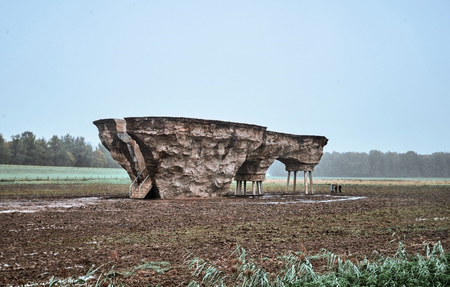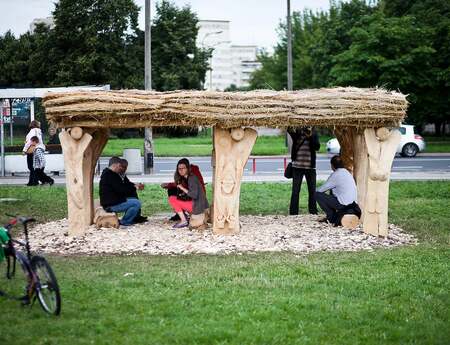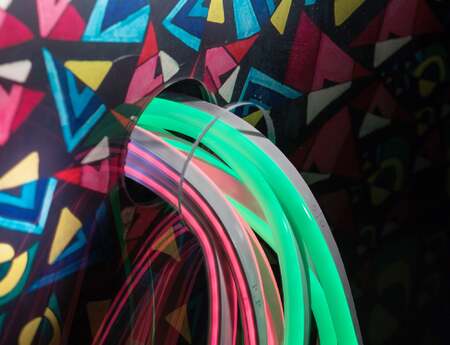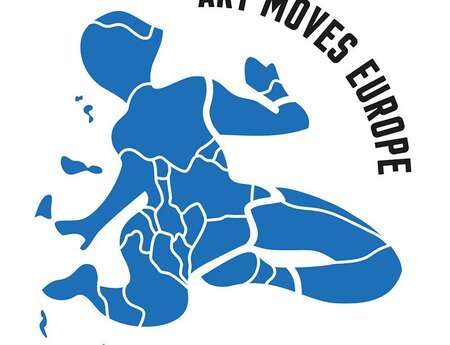Transformation of the Landscape Materialized in Dutch Land Art by Bob Gramsma
The Netherlands have been shaped by the struggle against water. Sea became land in Flevoland. This transformation is the reason for Land Art Flevoland, a series of nine land art works. The impressive concrete Riff, PD #18245 by Bob Gramsma (1963, CH/NL) was unveiled in 2019. With his work, Gramsma wants to show the traces of the reclamation.
Land Art in Flevoland
During the construction of the Flevopolder, the engineers and planners decided to provide space for a number of large land art works. From the seventies onward, world-famous artists such as Robert Morris, Richard Serra and Daniel Libeskind were invited to realise large-scale projects. Dutchman Piet Slegers built his Aardzee (en. Earthsea) in 1982, Marinus Boezem followed in 1996 with his Groene Kathedraal (en. Green Catherdral).
The most recent acquisitions are Exposure (2010), a giant seated man on the dike near Lelystad, made by the Brit Antony Gormley and Pier + Horizon (2016) by Paul de Kort. Riff, PD #18245 by Bob Gramsma is the eighth land art piece in the collection.
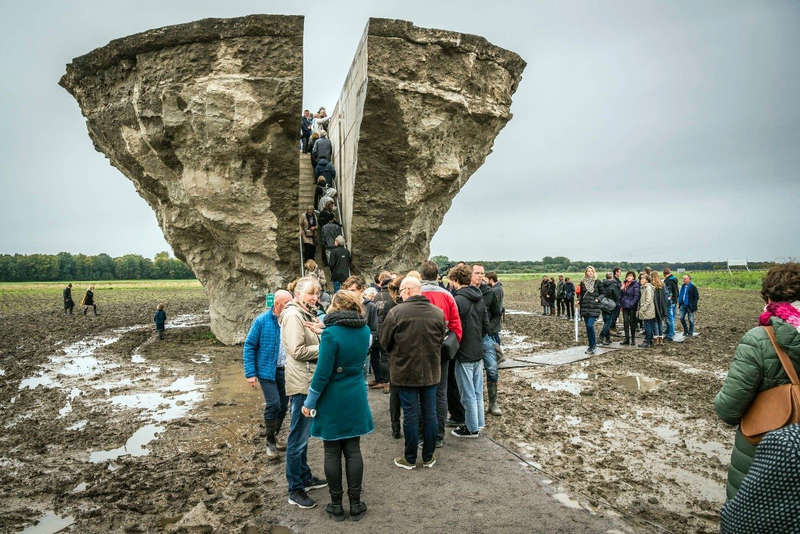
Seen from a bird’s eye, it's like a cloud-shaped landing spot for UFOs. Also, the front of the artwork could be that of a spaceship, with a staircase leading from the ground to a viewing platform. But seen from the side, Riff, PD #18245, the new land artwork by artist Bob Gramsma, looks outright organic – with eroded layers of soil like a canyon wall.
Riff, PD #18245, a concrete colossus of almost forty metres long and seven metres high, is Flevoland's eighth work of land art. In the past months, it has been erected on a plot of agricultural land near Dronten, just a stone's throw from the amusement park Walibi. It was commissioned by Flevoland Province to celebrate the 100th anniversary of the adoption of the Zuiderzee Act. Said law facilitated the implementation of engineer Cornelis Lely’s reclamation plans.
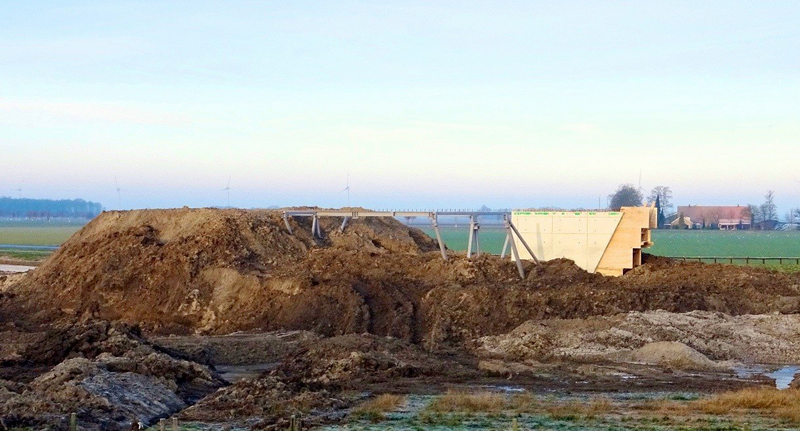
"With my artwork, I want to show the traces of those hundred years," says Bob Gramsma. His reef has literally been dug out of the polder clay. To realise the work, Gramsma first excavated 15,000 cubic metres of soil, right down to the groundwater level. With this mixture of agricultural and Zuiderzee soil, he formed a mound which he then started to hollow out from above – with machines, but also by hand. This created an amorphous hole – a shape for which there is actually no word. Finally, the cavity was covered with a thin skin of sprayed concrete, about fifteen centimetres thick. The soil was then removed leaving a residual shape.
A few weeks before delivery, the artist inspects the surface of Riff from a wobbly lifting platform. Gramsma points to the shells from the Zuiderzee bottom that have been cast in the concrete like fossils. Also the traces of the excavator are visible, and the artist's handprint. Cigarette packets and papers belonging to the construction workers have been left behind in the concrete. "This artwork is a reflection of the entire working process; you can see the geological timelines as it were."
He wanted to create a space, purely through the method of digging, Gramsma explains. "A sculptor usually departs from the outside, carving in stone or wood. I work from the inside outward, using the landscape as formwork. The volume and embedding of the work is precisely determined and calculated, but it is the outer layer, the appearance, that is a surprise".
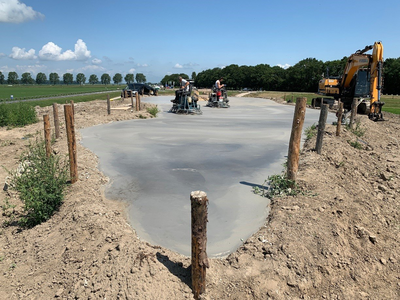
During his studies at the academy in Zurich, Gramsma discovered that digging could also be a way of sculpting. "I remember very well the time we were given the task to mold our own face. Back then I came up with the idea of digging my face out of the clay and filling the form with plaster. I was trying to understand what space is. Why don't we see the space surrounding us as a shape? I wanted to materialize that space".
Soon after his final exam, Gramsma was approached to submit a work for the sculpture exhibition of Sonsbeek '93 (art quadrennial at Arnhem, NL). He made a cast of the stairwell in his house in Arnhem by entirely covering the space with latex, sponsored by the company Durex. "It was a fully sealed space. Through the keyhole in the door, I could force air into the thin skin. Around that time, I discovered that the British artist Rachel Whiteread also worked with inverted volumes. Apparently, it was in the air." He adds laughing: "She just became a bit more famous than I did."
Holes don't seem to have a shape, Gramsma says. "However, if you materialize a space, the shape becomes visible." With its pointed front, the work near Dronten resembles a shark or alligator. "Maybe the artwork will even get a nickname in the vernacular," Gramsma chuckles, "and will soon be known as the crocodile of the Flevopolder".
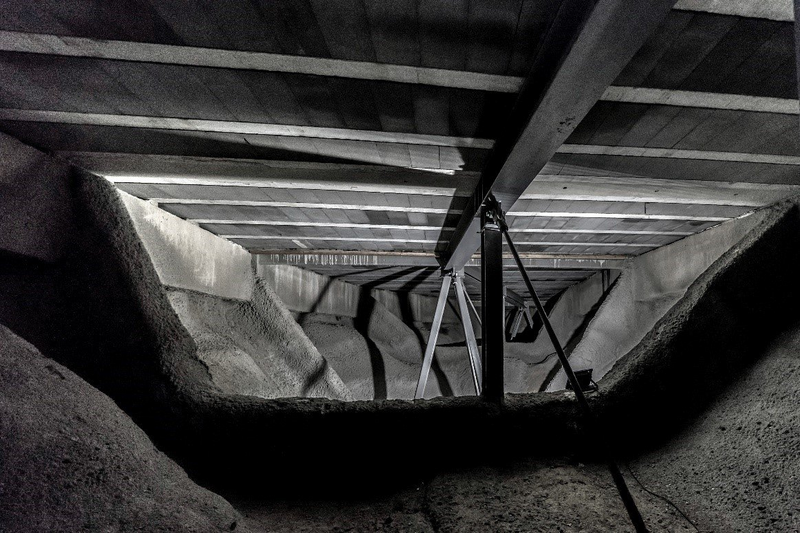
The intention is for nature to take possession of the work again in the years to come. "The concrete has been washed clean, but there is still enough clay residue for moss and weeds to grow," assures the artist. He deliberately left holes in the walls so that birds and bats could nest in the sculpture, which on the inside is hollow and irregular like a cave. "I am now giving the work back to the landscape so that it can grow slowly, just like a natural reef. In five years, it will look very different."
Land Art Flevoland is located in the central Netherlands, and open 24/7.
https://www.landartflevoland.nl/en/land-art/
Riff, PD #18245 can be found on the plot between Spijkweg and Bremerbergweg, municipality of Dronten (visitor address: Bremerbergdijk 10, 8256 RD Biddinghuizen).
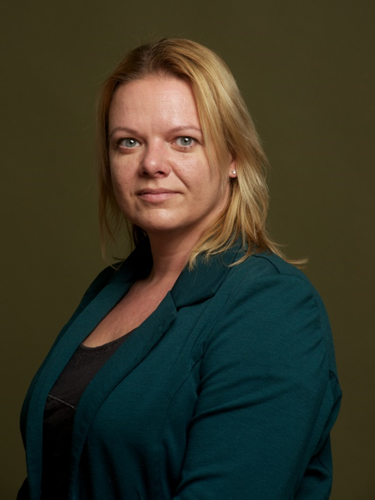
Author: Sandra Smallenburg
Sandra Smallenburg is an art historian and Head of Culture at NRC Media. In 2015 she published the book Expeditie Land Art. Landschapskunst in Amerika, Groot-Brittannië en Nederland (Publisher De Bezige Bij) and was curator of the eponymous exhibition at Kunsthal Kade, Amersfoort, NL.
This article by Sandra Smallenburg appeared in NRC Media on October 10, 2019 entitled Nieuwe land art: Bij Dronten is een betonnen ruimteschip geland. The opening of Riff, PD #18245 took place on October 12, 2019.
Cover picture: Bob Gramsma, "Riff, PD #18245", 2019. Photo: Andreas Galmarini
